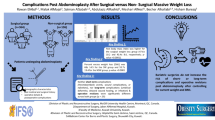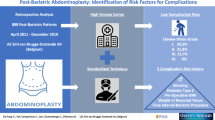Abstract
Introduction
Ex-obese patients present with redundancy of abdominal skin and soft tissue due to massive weight loss (MWL). The plastic surgeon can restore the body shape through body contouring procedures. Hence the need to adequately direct patients to body contouring by identifying suitable candidates exists. Our work aims to retrospectively analyze the abdominoplasty complications in our case series to identify associated risk factors and evaluate the effect of combined procedures on abdominoplasty outcomes.
Materials and Methods
We retrospectively investigated predictive factors of abdominoplasty procedure complications on 213 MWL patients who received abdominoplasty with and without rectus sheath plication, abdominal liposuction, and other body contouring procedures. We identified risk and protective factors with univariate and multivariate regression analysis. Furthermore, we assessed the impact of additional procedures on the complication rates.
Results
The overall complication rate was 49.8% (26.8% minor complications; 23% major complications). The delayed wound healing rate was 27.7%, and the revision surgery rate was 25.8% (14.7% early revision; 14.2% late revision). These results were compared with literature reports. Several negative predictors emerged as non-modifiable (advanced age, diabetes mellitus, surgical mode of weight loss) or modifiable (preoperative obesity and body mass index (BMI); active smoking; preoperative anemia; use of fibrin glue or quilting sutures). Performing rectus sheath plication improved most of the outcomes. Liposuction of hypochondriac regions and flanks led to increased safety and reduced the risk of surgical dehiscence and delayed wound healing, in contrast to epimesogastric liposuction. The other combined body contouring procedures did not worsen the outcomes, except for poor scarring.
Conclusion
Our findings encourage us to continue associating rectus sheath plication, liposuction, and other body contouring surgeries with abdominoplasty. We emphasize the importance of proper patient selection, particularly with regard to anemia, before body contouring surgery in the interests of offering safe surgery and satisfactory results. Further studies are needed to investigate how the optimal BMI cut-off and abstinence from smoking (in terms of time) before surgery reduce postoperative complications.
Level of Evidence IV
This journal requires that authors assign a level of evidence to each article. For a full description of these Evidence-Based Medicine ratings, please refer to the Table of Contents or the online Instructions to Authors https://www.springer.com/journal/00266.




Similar content being viewed by others
References
Rocha RI, Junior WC, Modolin MLA, Takahashi GG, Caldini ETEG, Gemperli R (2021) Skin changes due to massive weight loss: histological changes and the causes of the limited results of contouring surgeries. Obes Surg 31(4):1505–1513
ASPS (2021) 2020 National plastic surgery statistics. Cosmetic surgical procedures. Arlington Heights: American Society of Plastic Surgeons. https://www.plasticsurgery.org/documents/News/Statistics/2020/plastic-surgery-statistics-full-report-2020.pdf. Accessed 15 Nov 2021
Livingston EH (2002) Obesity and its surgical management. Am J Surg 184(2):103–113
Hasanbegovic E, Sørensen JA (2014) Complications following body contouring surgery after massive weight loss: a meta-analysis. J Plast Reconstr Aesthet Surg 67(3):295–301
BAPRAS (2017) UK Commissioning guide: Massive Weight Loss Body Contouring. London: British Association of Plastic, Reconstructive and Aesthetic Surgeons, The Royal College of Surgeons of England. https://www.bapras.org.uk/docs/default-source/commissioning-and-policy/2017--draft-for-consultation--body-contouring-surgery-commissioning.pdf?sfvrsn=0. Accessed 15 Nov 2021
ASPS (2017) Practice Parameter for Surgical Treatment of Skin Redundancy for Obese and Massive Weight Loss Patients. Arlington Heights: American Society of Plastic Surgeons. https://www.plasticsurgery.org/documents/Health-Policy/Guidelines/guideline-2017-skin-redundancy.pdf. Accessed 15 Nov 2021
Matarasso A (2010) Traditional abdominoplasty. Clin Plast Surg 37(3):415–437
Song AY, Jean RD, Hurwitz DJ, Fernstrom MH, Scott JA, Rubin JP (2005) A classification of contour deformities after bariatric weight loss: the Pittsburgh Rating Scale. Plast Reconstr Surg 116(5):1535–1544 (discussion 1545-6)
Nahas FX (2001) An aesthetic classification of the abdomen based on the myoaponeurotic layer. Plast Reconstr Surg 108(6):1787–1795 (discussion 1796-7)
WHO (2021) Haemoglobin concentrations for the diagnosis of anaemia and assessment of severity. Vitamin and Mineral Nutrition Information System. Geneva: World Health Organization. Available from: https://apps.who.int/iris/bitstream/handle/10665/85839/WHO_NMH_NHD_MNM_11.1_eng.pdf. Accessed 15 Nov 2021
Vernon S (1957) Umbilical transplantation upward and abdominal contouring in lipectomy. Am J Surg 94(3):490–492
Persichetti P, Simone P, Scuderi N (2005) Anchor-line abdominoplasty: a comprehensive approach to abdominal wall reconstruction and body contouring. Plast Reconstr Surg 116(1):289–294
Fang RC, Lin SJ, Mustoe TA (2010) Abdominoplasty flap elevation in a more superficial plane: decreasing the need for drains. Plast Reconstr Surg 125(2):677–682
Pitanguy I (1967) Abdominoplastias. O. Hospital 71:1541
Nahabedian MY (2018) Management strategies for diastasis recti. Semin Plast Surg 32(3):147–154
Michaels J 5th, Coon D, Rubin JP (2011) Complications in postbariatric body contouring: postoperative management and treatment. Plast Reconstr Surg 127(4):1693–1700
Momeni A, Heier M, Bannasch H, Stark GB (2009) Complications in abdominoplasty: a risk factor analysis. J Plast Reconstr Aesthet Surg 62(10):1250–1254
Brito ÍM, Meireles R, Baltazar J, Brandão C, Sanches F, Freire-Santos MJ (2020) Abdominoplasty and patient safety: the impact of body mass index and bariatric surgery on complications profile. Aesthetic Plast Surg 44(5):1615–1624
Winocour J, Gupta V, Ramirez JR, Shack RB, Grotting JC, Higdon KK (2015) Abdominoplasty: risk factors, complication rates, and safety of combined procedures. Plast Reconstr Surg 136(5):597e–606e
Neaman KC, Hansen JE (2007) Analysis of complications from abdominoplasty: a review of 206 cases at a university hospital. Ann Plast Surg 58(3):292–298
Batac J, Hamade M, Hamade H, Glickman L (2019) Abdominoplasty in the obese patient: risk versus reward. Plast Reconstr Surg 143(4):721e–726e
Neaman KC, Armstrong SD, Baca ME, Albert M, Vander Woude DL, Renucci JD (2013) Outcomes of traditional cosmetic abdominoplasty in a community setting: a retrospective analysis of 1008 patients. Plast Reconstr Surg 131(3):403e–410e
De Paep K, Van Campenhout I, Van Cauwenberge S, Dillemans B (2021) Post-bariatric abdominoplasty: identification of risk factors for complications. Obes Surg 31(7):3203–3209
Vastine VL, Morgan RF, Williams GS, Gampper TJ, Drake DB, Knox LK, Lin KY (1999) Wound complications of abdominoplasty in obese patients. Ann Plast Surg 42(1):34–39
Zuelzer HB, Ratliff CR, Drake DB (2010) Complications of abdominal contouring surgery in obese patients: current status. Ann Plast Surg 64(5):598–604
Gutowski KA (2018) Evidence-based medicine: abdominoplasty. Plast Reconstr Surg 141(2):286e–299e
Hammond DC, Chandler AR, Baca ME, Li YK, Lynn JV (2019) Abdominoplasty in the overweight and obese population: outcomes and patient satisfaction. Plast Reconstr Surg 144(4):847–853
Hurvitz KA, Olaya WA, Nguyen A, Wells JH (2014) Evidence-based medicine: abdominoplasty. Plast Reconstr Surg 133(5):1214–1221
Massenburg BB, Sanati-Mehrizy P, Jablonka EM, Taub PJ (2015) Risk factors for readmission and adverse outcomes in abdominoplasty. Plast Reconstr Surg 136(5):968–977
Clavien PA, Barkun J, de Oliveira ML, Vauthey JN, Dindo D, Schulick RD, de Santibañes E, Pekolj J, Slankamenac K, Bassi C, Graf R, Vonlanthen R, Padbury R, Cameron JL, Makuuchi M (2009) The Clavien-Dindo classification of surgical complications: five-year experience. Ann Surg 250(2):187–196
Dreifke MB, Jayasuriya AA, Jayasuriya AC (2015) Current wound healing procedures and potential care. Mater Sci Eng C Mater Biol Appl 48:651–662
Hester TR Jr, Baird W, Bostwick J 3rd, Nahai F, Cukic J (1989) Abdominoplasty combined with other major surgical procedures: Safe or sorry? Plast Reconstr Surg 83(6):997–1004
Hensel JM, Lehman JA Jr, Tantri MP, Parker MG, Wagner DS, Topham NS (2001) An outcomes analysis and satisfaction survey of 199 consecutive abdominoplasties. Ann Plast Surg 46(4):357–363
van Uchelen JH, Werker PM, Kon M (2001) Complications of abdominoplasty in 86 patients. Plast Reconstr Surg 107(7):1869–1873
Rosen RD, Manna B (2021) Wound Dehiscence. In: StatPearls [Internet]. Treasure Island (FL): StatPearls Publishing. https://www.ncbi.nlm.nih.gov/books/NBK551712/
Thomas HC (2011) Checklist for factors affecting wound healing. Adv Skin Wound Care 24(4):192
Stewart KJ, Stewart DA, Coghlan B, Harrison DH, Jones BM, Waterhouse N (2006) Complications of 278 consecutive abdominoplasties. J Plast Reconstr Aesthet Surg 59(11):1152–1155
Floros C, Davis PK (1991) Complications and long-term results following abdominoplasty: a retrospective study. Br J Plast Surg 44(3):190–194
Pilone V, Vitiello A, Borriello C, Gargiulo S, Forestieri P (2015) The use of a fibrin glue with a low concentration of thrombin decreases seroma formation in postbariatric patients undergoing circular abdominoplasty. Obes Surg 25(2):354–359
Lee JC, Teitelbaum J, Shajan JK, Naram A, Chao J (2012) The effect of fibrin sealant on the prevention of seroma formation after postbariatric abdominoplasty. Can J Plast Surg Fall 20(3):178–180
Andrades P, Prado A, Danilla S, Guerra C, Benitez S, Sepulveda S, Sciarraffia C, De Carolis V (2007) Progressive tension sutures in the prevention of postabdominoplasty seroma: a prospective, randomized, double-blind clinical trial. Plast Reconstr Surg 120(4):935–946
Ardehali B, Fiorentino F (2017) A meta-analysis of the effects of abdominoplasty modifications on the incidence of postoperative seroma. Aesthet Surg J 37(10):1136–1143
Ho W, Jones CD, Pitt E, Hallam MJ (2020) Meta-analysis on the comparative efficacy of drains, progressive tension sutures and subscarpal fat preservation in reducing complications of abdominoplasty. J Plast Reconstr Aesthet Surg 73(5):828–840
Coon D, Gusenoff JA, Kannan N, El Khoudary SR, Naghshineh N, Rubin JP (2009) Body mass and surgical complications in the postbariatric reconstructive patient: analysis of 511 cases. Ann Surg 249(3):397–401
Au K, Hazard SW 3rd, Dyer AM, Boustred AM, Mackay DR, Miraliakbari R (2008) Correlation of complications of body contouring surgery with increasing body mass index. Aesthet Surg J 28(4):425–429
Lotfi P, Engdahl R (2019) Concepts and techniques in postbariatric body contouring: a primer for the internist. Am J Med 132(9):1017–1026
Draaijers LJ, Tempelman FR, Botman YA, Tuinebreijer WE, Middelkoop E, Kreis RW, van Zuijlen PP (2004) The patient and observer scar assessment scale: a reliable and feasible tool for scar evaluation. Plast Reconstr Surg 113(7):1960–1965 (discussion 1966-7)
Enrique Bayter-Marin J, Cárdenas-Camarena L, Peña WE, Durán H, Ramos-Gallardo G, Robles-Cervantes JA, McCormick-Méndez M, Rocio Gómez-González S, Liliana P-R (2021) Patient blood management strategies to avoid transfusions in body contouring operations: controlled clinical trial. Plast Reconstr Surg 147(2):355–363
Parvizi D, Friedl H, Wurzer P, Kamolz L, Lebo P, Tuca A, Rappl T, Wiedner M, Kuess K, Grohmann M, Koch H (2015) A multiple regression analysis of postoperative complications after body-contouring surgery: a retrospective analysis of 205 patients: regression analysis of complications. Obes Surg 25(8):1482–1490
Funding
The authors received no funding or financial support for the research of this article.
Author information
Authors and Affiliations
Corresponding author
Ethics declarations
Conflict of interest
The authors declare that they have no conflict of interest.
Ethical Approval
All procedures performed in studies involving human participants were in accordance with the ethical standards of the institutional and/or national research committee and with the 1964 Declaration of Helsinki and its later amendments or comparable ethical standards.
Informed Consent
For this type of retrospective study, informed consent is not required.
Additional information
Publisher's Note
Springer Nature remains neutral with regard to jurisdictional claims in published maps and institutional affiliations.
Rights and permissions
Springer Nature or its licensor (e.g. a society or other partner) holds exclusive rights to this article under a publishing agreement with the author(s) or other rightsholder(s); author self-archiving of the accepted manuscript version of this article is solely governed by the terms of such publishing agreement and applicable law.
About this article
Cite this article
Marchica, P., Costa, A.L., Brambullo, T. et al. Retrospective Analysis of Predictive Factors for Complications in Abdominoplasty in Massive Weight Loss Patients. Aesth Plast Surg 47, 1447–1458 (2023). https://doi.org/10.1007/s00266-022-03235-5
Received:
Accepted:
Published:
Issue Date:
DOI: https://doi.org/10.1007/s00266-022-03235-5




